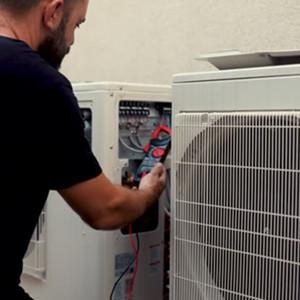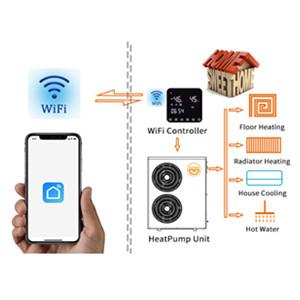Air Source Heat Pump Outlet Temperature
A heat pump transfers heat from the outside air into your home, making
it an efficient and cost-effective method of heating and cooling. However, the
output of an air source heat pump will vary depending on the outdoor
temperature and the setting of the thermostat.
So, how hot should the air from the heat pump be? In heating mode
without auxiliary heating, the average temperature output of the heat pump is
85°F to 92°F. Typically, a heat pump in heating mode will create a temperature
difference of 15-20°F above the current air temperature. The air temperature of
a heat pump varies with the age and condition of the heat pump.
This article will further explore some of the questions you may have
about heat pumps and their use. Read on to learn more about how to use a heat
pump and save on your energy bills!
The average heat output can be 85-92°F; however, the temperature of the
heat pump output depends on several factors, including the age and condition of
the heat pump. New heat pumps with R410a refrigerant can extract more heat from
the outside air, increasing output.
At what temperature should the AUX heating start?
Heat pumps use refrigerants and heat exchangers to extract heat from the
outside air, even in cold weather. Below 30 degrees, however, they lose a lot
of efficiency and need help keeping up with the thermostat.
So, how much temperature will the Aux heat turn on? When the outside air
temperature drops below 30°F, the heat pump will automatically activate
auxiliary heating. The heat pump will also use emergency auxiliary heating in
heating mode if the thermostat raises the temperature by more than 2°F.
For example, if the outside temperature is 40°F and the indoor
thermostat reads 67°F, setting the thermostat to 74°F will enable auxiliary
heating to help reach the desired temperature of 74°F as quickly as possible.
In heating mode, the heat pump will use emergency heating to help reach a
comfortable temperature as quickly as possible.
Since heat pumps use outside air, they often need help heating your home
when it's cold. Due to this feature, AUX heat comes into play at low
temperatures. To understand the optimal temperature for AUX heating, you must
first understand how it works.

What is AUX heating?
Heat pumps extract heat from the outside air to heat your house, which
works well in the warmer months but can be difficult to do in colder weather.
Unfortunately, when the air freezes, not enough heat is extracted from the
outdoor air to heat your home without help. The heat pump brings in less air
than the building loses heat. In this case, you need AUX heat to meet the
demand.
Auxiliary heat (also known as an auxiliary, supplemental, or emergency
heat source) can be a gas furnace or hot plate backup that turns on to help the
heat pump heat the home when the temperature drops below 30°F.
Auxiliary heat helps the heat pump compress the heat to keep you warm in
cold weather.
It must be understood that auxiliary heating is not used. In summer, you
can spend months without AUX heat and relying on a heat pump.
Depending on where you live, auxiliary heating is usually used during
the cold winter and late fall. Northerners will use their AUX heat more often,
but if you live in the warmer South, you can usually avoid it.
Finally, auxiliary heat works with your heat pump to separate it from
emergency heat.
Auxiliary, Standby and Emergency Heat: Is there a Difference?
Many people confuse auxiliary heat, backup heat, and emergency heat. There's
no real difference between the three, it references the same components inside
the heat pump. Auxiliary heating, backup heating and emergency heating use the
same hot plate or gas furnace to supplement the heat pump to heat your home.
The difference between auxiliary heating and emergency heating is
simple: the emergency heating setting on the thermostat allows you to bypass
the heat pump and use only the hotplate. Aux heat combines heating strips and
heat pumps to automatically heat your home without you having to do anything.
In addition, the auxiliary heating will automatically turn on at a
certain temperature. If there is a problem with the heat pump, homeowners
should manually turn on emergency heating. If emergency heating automatically
turns on, your heat pump may be damaged or damaged.
Emergency heat explained
Emergency heating can be turned on when your heat pump is not working or
damaged. This setting causes your thermostat and heating system to
automatically draw heat from your secondary heat source, which could be a
furnace or a hotplate. Heating strips are located inside the indoor air handler
and heat the air before it enters the ductwork and is then distributed through
the house.
When using emergency heating, your heat pump will not. In general,
emergency heating is used to warm your home if there is a problem with your
heat pump or if it cannot adequately heat your home.
At what temperature should AUX Heat be turned on?
Your auxiliary heating should turn on when the outside temperature is
close to 30°F and below. This temperature is when your air source heat pump struggles to get enough heat from the outside air to warm your house. So when
the temperature is below 30 degrees, AUX heat is needed to supplement your heat
pump.
When this 30 degree temperature is reached, your AUX heating should
automatically turn on - you don't need to do it manually. If your auxiliary
heating is on when the weather is warm, you should contact a professional to
help you find the problem.
What temperature should I set my heat pump to in winter?
When manipulating thermostat settings in winter, we encourage homeowners
to set the heat to the lowest temperature they can handle. This will be
different for everyone.
Ideally, the most energy-efficient setting for winter is to set the
temperature to 68°F and keep the thermostat alone. If you need more warmth,
increase the temperature by 1° until you find your ideal comfort setting.
Are you considering a dual fuel heat pump? See our article Are Dual Fuel
Heat Pumps Worth It? What do you need to know.
As I discussed, air source heat pumps operate by taking energy from the
surrounding environment and raising the temperature for heating or lowering the
temperature for cooling. The greater the difference between outdoor and indoor
air temperatures, the less efficient the heat pump system will be.
This inefficiency can cause your heating system to burn more energy and
increase your energy bills. Fundamentally, the best way to reduce
inefficiencies and avoid high energy bills is to close the gap between your
outdoor air temperature and your thermostat.
Frequently setting your thermostat to high temperatures, especially in
winter, can exacerbate energy losses in your home and increase your energy
bills.
However, in the cold winter months, when you want to stay warm, setting
the thermostat on low isn't an option. Fortunately, getting the heat pump at
the right temperature can help reduce energy bills and maximize the efficiency
of the heat pump.
For maximum comfort and efficiency, you should set your thermostat
between 68 and 72 degrees Fahrenheit. This temperature is comfortable for most
people and keeps everyone warm with typical clothing while minimizing heat
loss.
When no one is home, setting your heat pump between 58 and 62 degrees
Fahrenheit allows you to save on heating bills without worrying about making
your family cold or uncomfortable.
There are a wide variety of heat pump thermostats on the market. A
programmable thermostat will manage the temperature settings for you. A
programmable thermostat is a digital thermostat that helps you pinpoint
temperature readings with minimal guesswork.
In recent years, smart thermostats, such as Nest or ecobee, have used
advanced artificial intelligence technology to manage indoor comfort. Smart
thermostats can even learn based on the environment. These heat pump
thermostats are great for maintaining a constant temperature in your home.
Should a heat pump run continuously in winter?
While heat pumps are less effective at freezing and sub-freezing
temperatures, they can technically operate continuously in winter without the
help of auxiliary heat. However, to save money and energy, you shouldn't run
your heat pump continuously in the winter -- always turn it off when not in use.
For example, if you're going to be away overnight or throughout the day,
you can turn off the heat pump and set a timer to turn it back on before you
return. If you set the timer to turn about half an hour before you get home, it
should be warm when you arrive.
Ultimately, turning off the heat pump as much as possible will maximize
energy savings. If your main concern is saving money during the winter months,
you can even set your timer so that your heat pump turns off for a few hours at
night when you go to bed, then turns it back on before you wake up!
Will the heat pump work in defrost mode
Finally, if you see ice on your outdoor unit, your system may be in
defrost mode. The heat pump may temporarily go into defrost mode to avoid
freezing. If you see ice on the outdoor coil, defrost mode must melt the ice to
prevent system failure.
In defrost mode, the emergency heating plate (or gas backup furnace) and
heat pump can run simultaneously to maintain an even room temperature. The
indoor unit senses that the air temperature is too low; emergency heat or
furnace will replenish while the defrost cycle heats the outdoor coil.
The outdoor coil needs to be kept free of ice to prevent damage to the
fan motor and compressor inside the outdoor unit.
In conclusion
Overall, the heat pump should be about 20 degrees warmer than the
outside temperature in heating mode. When it's too cold outside and your heat
pump can't keep up with your heating needs, auxiliary heat will supplement it
to keep your home warm.
This is often necessary during winter months when the heat pump is less
efficient and you should set the heat pump between 68 and 72 degrees Fahrenheit
(20 and 22 degrees Celsius) to maximize energy efficiency.
Lastly, don't leave your heat pump running continuously in winter or
your heating bills will be higher - try turning your heat pump off when not in
use.





